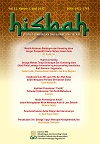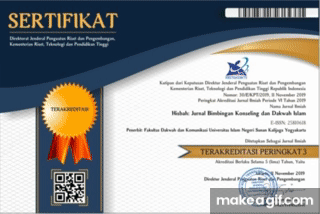FENOMENA BODYSHAMING PADA MAHASISWI BKI IAIN SURAKARTA
DOI:
https://doi.org/10.14421/hisbah.2022.191-08Abstract
The behavior known as "body shaming" is often taken for granted. Many people believe that it is acceptable to comment about other people's bodies and physical appearance; however, they do not understand that their actions can harm another person or contribute to the development of psychological disorders in that person. Each person is unique, and one of the distinguishing characteristics of him/her is his/her freedom to choose his/her own body, including the right to be fat, thin, or any other body type. The purpose of this study was to determine the phenomenon of body shaming among Bimbingan Konseling Islam (BKI) female students of class 2017 at IAIN Surakarta (now UIN Raden Mas Said). This study used a qualitative descriptive technique. The four women who volunteered to participate in the study were all familiar with the idea of shame. Data collection methods used in this study were interviews, observations, and questionnaires. The findings reveal that (1) bullying is similar to body shaming, (2) body shaming can prohibit people from participating in social activities because it makes them feel insecure, and (3) negative responses to body shaming can cause unpleasant sensations.
Keywords: Body Shaming, Students of IAIN Surakarta, Phenomenon.
 Abstract viewed: 953 times
|
Abstract viewed: 953 times
|
 PDF downloaded = 1058 times
PDF downloaded = 1058 times
References
Chairani, L.-. (2018). Body Shame dan Gangguan Makan: Kajian Meta-Analisis. Buletin Psikologi, 26(1), 12–27. https://doi.org/10.22146/buletinpsikologi.27084
Claudat, K., Warren, C. S., & Durette, R. T. (2012). The Relationships Between Body Surveillance, Body Shame, and Contextual Body Concern during Sexual Activities in Ethnically Diverse Female College Students. Body Image, 9(4), 448–454. https://doi.org/10.1016/j.bodyim.2012.05.007
Creswell, J. W. (2009). Research Design: Pendekatan Kualitatif, Kuantitatif dan Mixed. Pustaka Belajar.
Elíasdóttir, E. L. F. (2016). Is Body Shaming Predicting Poor Physical Health and Is There a Gender Difference? Is Body Shaming Predicting Poor Physical Health and Is There a Gender Difference? https://skemman.is/bitstream/1946/25652/1/BSc thesis - Eva Lind Fells .pdf
Fredrickson, B. L., & Roberts, T. A. (1997). Toward Understanding Women’s Lived Experiences and Mental Health Risks. Psychology of Women Quarterly, 21(2), 173–206. https://doi.org/10.1111/j.1471-6402.1997.tb00108.x
Gam, R. T., Singh, S. K., Manar, M., Kar, S. K., & Gupta, A. (2020). Body Shaming Among School-Going Adolescents: Prevalence and Predictors. International Journal Of Community Medicine And Public Health, 7(4), 1324. https://doi.org/10.18203/2394-6040.ijcmph20201075
Hasmalawati, N. (2017). Pengaruh Citra Tubuh dan Perilaku Makan Terhadap Penerimaan Diri Pada Wanita. Jurnal Psikoislamedia, 2(2), 107–115.
Muhsin, A. (2015). Studi Kasus Ketidakpuasan Remaja Putri Terhadap Keadaan Tubuhnya (Body Image Negative pada Remaja Putri). Skripsi, 4(1), 1–10.
Permatasari, D. (2017). Fenomena Social Climber di Kalangan Mahasiswa (Studi Fenomenlogi pada Mahasiswa di Surakarta), Skripsi, IAIN Surakarta.
Puluhulawa, M. R. U., & Husain, R. (2021). Body Shaming Through Social Media As a Digital Crime In The Era of Disruption. Jambura Law Review, 3(1), 112–123. https://doi.org/10.33756/jlr.v3i1.7200
Rachmah, E. N., & Baharuddin, F. (2019). Faktor Pembentuk Perilaku Body Shaming di Media Sosial. Seminar Nasiional Psikologi Sosial Di Era Revolusi Industri 4.0; Peluang Dan Tantangan, 66–73. http://fppsi.um.ac.id/wp-content/uploads/2019/07/Eva-Nur.pdf
Regita Cahyani, R., & Lubabin Nuqul, F. (2019). Efektivitas Cognitive Behavior Therapy Untuk Menurunkan Body Shame. Jurnal Intervensi Psikologi (JIP), 11(2), 91–100. https://doi.org/10.20885/intervensipsikologi.vol11.iss2.art3
Widiaswati, N. L. R. (2016). Profil Citra Tubuh (Body Image) Pada Remaja dan Implikasinya bagi Bimbingan dan Konseling. Repository.Upi.Edu, 2006, 87–91.

Downloads
Published
Issue
Section
License
Authors who publish with this journal agree to the following terms:
- Authors retain copyright and grant the journal right of first publication with the work simultaneously licensed under a Creative Commons Attribution License that allows others to share the work with an acknowledgement of the work's authorship and initial publication in this journal.
- Authors are able to enter into separate, additional contractual arrangements for the non-exclusive distribution of the journal's published version of the work (e.g., post it to an institutional repository or publish it in a book), with an acknowledgement of its initial publication in this journal.
- Authors are permitted and encouraged to post their work online (e.g., in institutional repositories or on their website) prior to and during the submission process, as it can lead to productive exchanges, as well as earlier and greater citation of published work.











